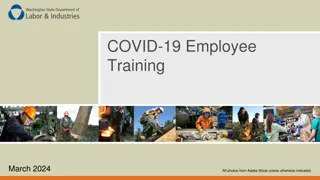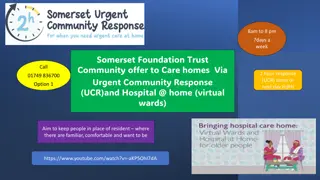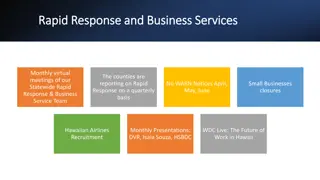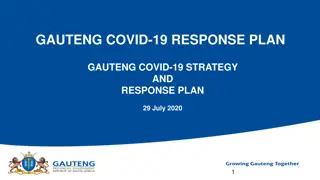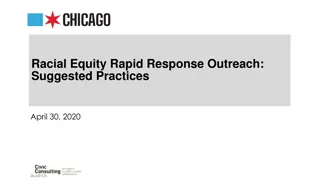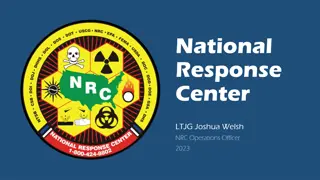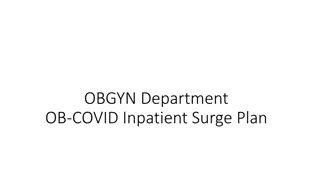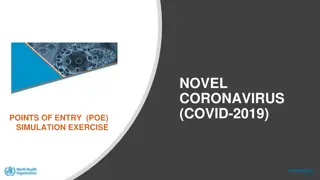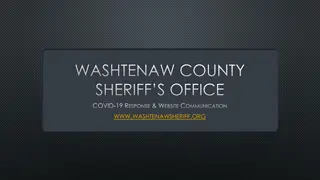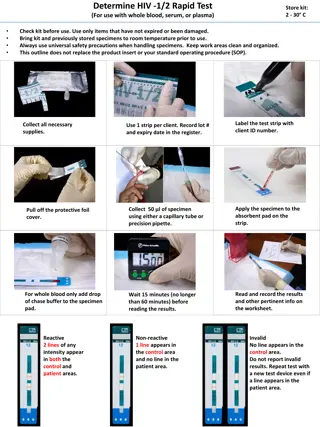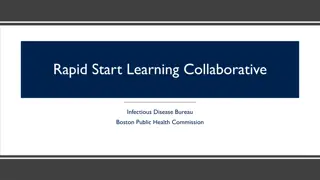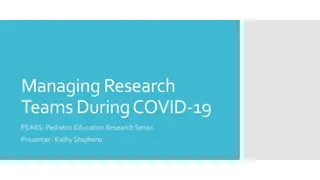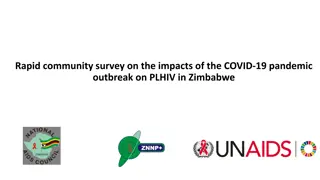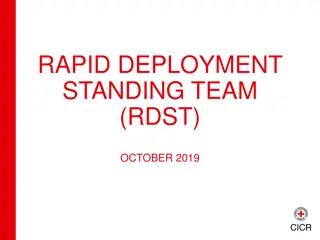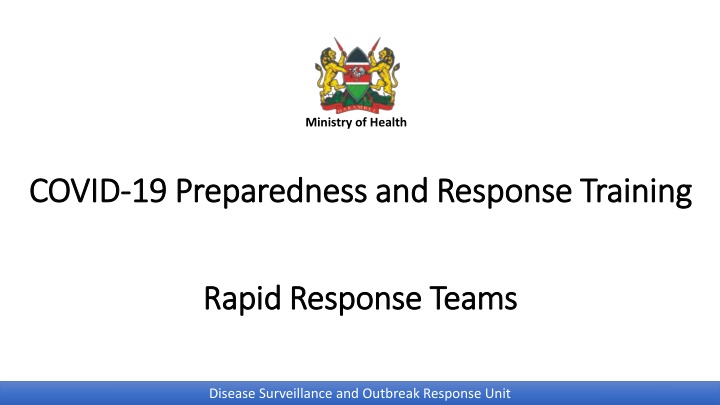
COVID-19 Rapid Response Team Training Overview
Explore the key components of Rapid Response Teams (RRTs) for COVID-19 preparedness and response. Learn about RRT composition, roles, responsibilities, and why they are crucial for timely outbreak response. Discover the vital role of Team Leaders in organizing and coordinating RRT activities.
Download Presentation

Please find below an Image/Link to download the presentation.
The content on the website is provided AS IS for your information and personal use only. It may not be sold, licensed, or shared on other websites without obtaining consent from the author. If you encounter any issues during the download, it is possible that the publisher has removed the file from their server.
You are allowed to download the files provided on this website for personal or commercial use, subject to the condition that they are used lawfully. All files are the property of their respective owners.
The content on the website is provided AS IS for your information and personal use only. It may not be sold, licensed, or shared on other websites without obtaining consent from the author.
E N D
Presentation Transcript
Ministry of Health COVID COVID- -19 Preparedness and Response Training 19 Preparedness and Response Training Rapid Response Teams Rapid Response Teams Disease Surveillance and Outbreak Response Unit
Learning objectives Learning objectives At the end of this session you should be able to: Explain what is a RRT, its role and characteristics Describe the composition of a RRT List the roles and responsibilities of the RRT members Understand the lists of critical contacts Constitute necessary equipment and items
What is a RRT What is a RRT A Rapid Response Team is a multi-disciplinary team that works to ensure rapid, coordinated detection, investigation and response to outbreaks of diseases and events of public health concern
Why RRT? Why RRT? They are the first technical teams to timely respond to any public health events A fully operational RRT is critical to be able to act immediately (within 24 hrs) once a suspected case is reported The RRT will act as an initial stabilizing resource in the earliest phase of the outbreak
Composition of RRTs Composition of RRTs National and County level Team leader - appointed by the organizations Surveillance officer / Epidemiologists Medical laboratory scientist Environmental health officer /Public health officer Clinician (Medical Officer, Clinical Officer, Nursing Officer) Health promotion officer Veterinarian in case of a zoonotic disease outbreak Logistician Others as needed
Team leader Team leader Organizes the RRT in planning for an investigation Defines to the RRT members the objectives of the investigation Assigns tasks to each member on the team Reports to relevant national authorities (eg EOC) and communicates to the relevant authorities as per existing channels Ensures a coordinated response among team members Collects information from all team members daily such as epidemiological data, response activities, challenges and recommendations Responsible for the welfare of the team
Epidemiologist/Surveillance Coordinator 1/2 Epidemiologist/Surveillance Coordinator 1/2 Responsible for surveillance and epidemiological investigation (analysis by person, place and time) Updates and shares surveillance data with the team and with coordination units at local, sub-national and national levels Actively seeks information on other cases and ensures contact monitoring Identifies potential modes of exposure to community transmission Develops strategies to determine the etiology of the disease
Epidemiologist/Surveillance Coordinator 2/2 Epidemiologist/Surveillance Coordinator 2/2 Sets up mechanisms to stop the exposure depending on investigation results Provides case definitions and signals to health workers and the community Takes patient history in order to identify other cases Collects, analyses and interprets data Supervises data management Write reports and submits to the team leader
Clinician Clinician Provides direct support to case management in health care centers and in the community Provides advice and recommendations on clinical management Fills-in the investigation form with clinical signs of cases Supports the assessment of IPC in health care centers and puts in place IPC measures Collects information on patient history, treatment and follow-up to improve the clinical response Decides with Epidemiologist if case is suspected or probable, based on case definitions Informs the patient/family/caregivers of laboratory findings and their interpretation, and about the next steps Reports findings to the team and team leader takes the next steps
Laboratory personnel Laboratory personnel Responsible for setting up an operational system to ensure the safe and appropriate collection, package and transportation of samples from affected areas to the designated laboratory and dissemination of result to the RRT Ensures that all laboratory equipment and supplies for specimen collection are available Ensures specimen referral system and procedures are in place and shared with health facilities, County and national level Sets-up systems to maintain an efficient collaboration between epidemiologists, health care centers and laboratories Responsible for laboratory protocols and Biosafety and IPC standards implementation and adherence, including quality control Ensures all laboratory personnel are trained on safe triple packaging, and IPC procedures in handling blood specimens
Health Health Promotion Promotion Officer Officer Undertakes rapid assessments to understand the perceptions, knowledge, believes, practices in communities and at health care centers in affected areas Identify the socio-cultural and organizational factors that can affect/stimulate the adoption of control measures Supports media and public communication and engagement Ensures the availability of communication materials and tools; identifies the appropriate language and format at all levels Makes recommendations to set-up an appropriate communication strategy Develops mobilization strategies that support the adoption of IPC measures Introduces the team and explains the objectives of the visit
Logistician Logistician Responsible for the transport of teams, materials and specimens Ensures the availability and maintenance of essential material, such as medicines, vaccines and Personal Protective Equipment to be used during the investigation or the response Maps out locations of equipment and supplies for the response with capacities for storage, warehousing including maintaining inventory Provides logistical support for transportation of samples to laboratories Sets-up communication equipment Coordinates the security of the team Ensures that administrative processes are respected during field operations and ensures financial management
Infection Prevention and Control Expert Infection Prevention and Control Expert Responsible for IPC protocols (SOP, guidelines) implementation and adherence, including quality control during all RRT activities Ensures IPC personnel are equipped and trained on safety, and IPC procedures and protocols Ensures IPC equipment, materials, and supplies are available and on location as required Support IPC activities for laboratory
Others Others Environmental health Officer /WASH Officer Animal health officers
Key RRT contact list Key RRT contact list Hot line to Call Centre/EOC Medical Officer at Call Centre County Director of Health/SCMOH Incident Manager Investigation/Rapid Response Team Ambulance (Transfer) Team Designated isolation unit Designated Laboratory Disinfection team National MOH / PHEOC Relevant partners and stakeholders Others
Equipment/Material Requirements Equipment/Material Requirements - -1 1 Depend on the particular event May include Case definitions, contacts tracing tools Field investigation guidelines and forms Alcohol-based disinfectant Personal Protection Equipment (PPEs) Infection prevention and control (IPC) materials and supplies Cell Phones or other reliable communication equipment
Equipment/Material Requirements Equipment/Material Requirements - -2 2 Information Education and Communication materials (in appropriate language) Laboratory materials ( sample collection, packaging and transport materials) Dedicated vehicles (land, air or sea as needed) including access to ambulances Thermo-flash no-contact infrared thermometers GPS
Effective Coordination Effective Coordination 1.National/County/sub-county departments, etc. 2.Other non-governmental health stakeholders 3.With local authorities 4.With team members Communicate Delegate Establish clear lines of responsibilities Stress management strategies 18
Field deployment Field deployment to succeed: to succeed: Team formation guided by plan of response Team safety first first aid, vaccination, mosquito nets, repellent, food, water, fuel, PPE, etc Excellent logistics support - supplies, equipment, appropriate vehicles, accommodation Good rapport with local authority and community leadership Local human health providers, animal health providers Other local stakeholders Learn about local environment local knowledge, maps Sharing information at all level and provide feedback Guidelines, SOPs, information and communication tools
Thank you 20 Disease Surveillance and Outbreak Response Unit

